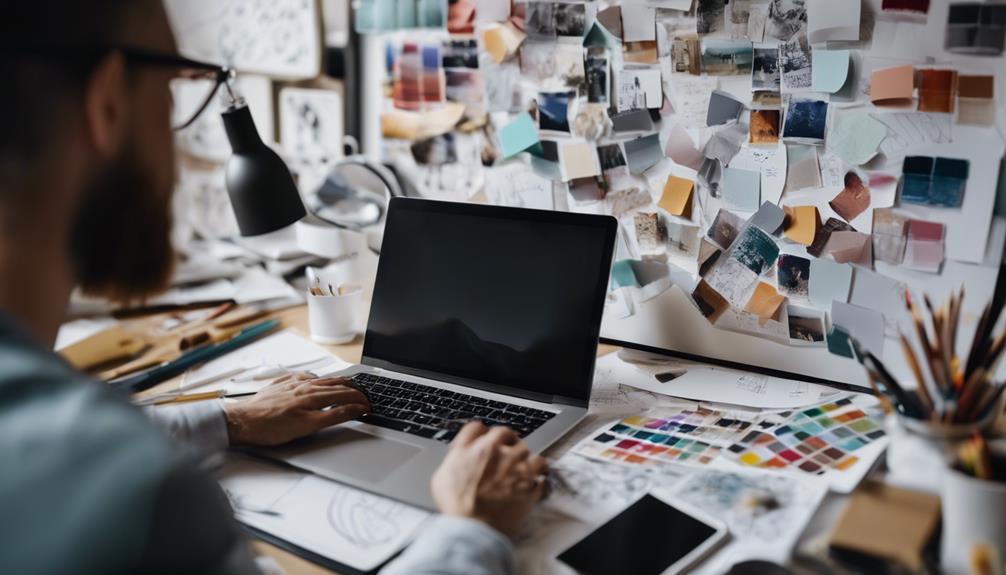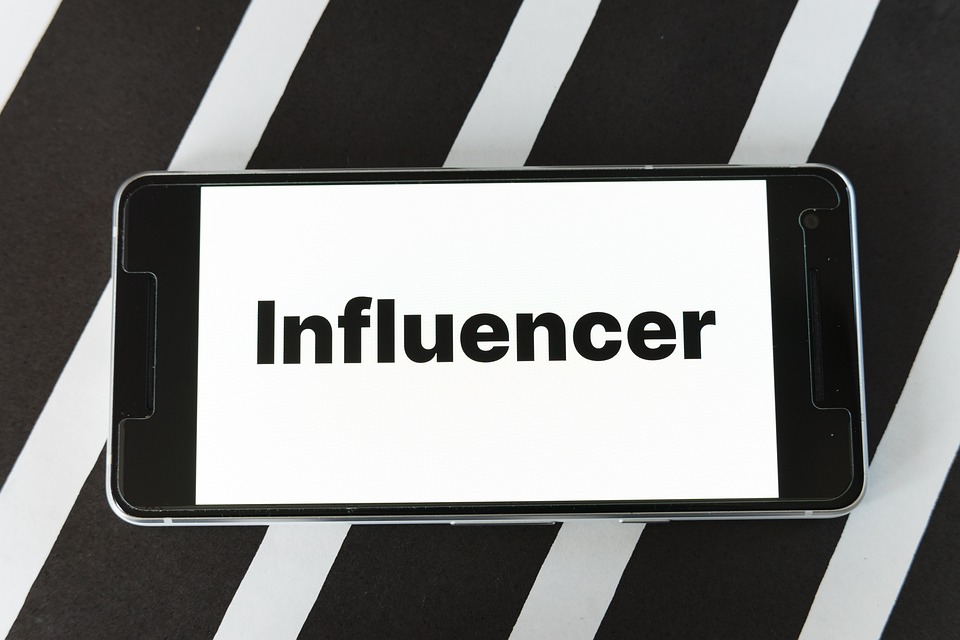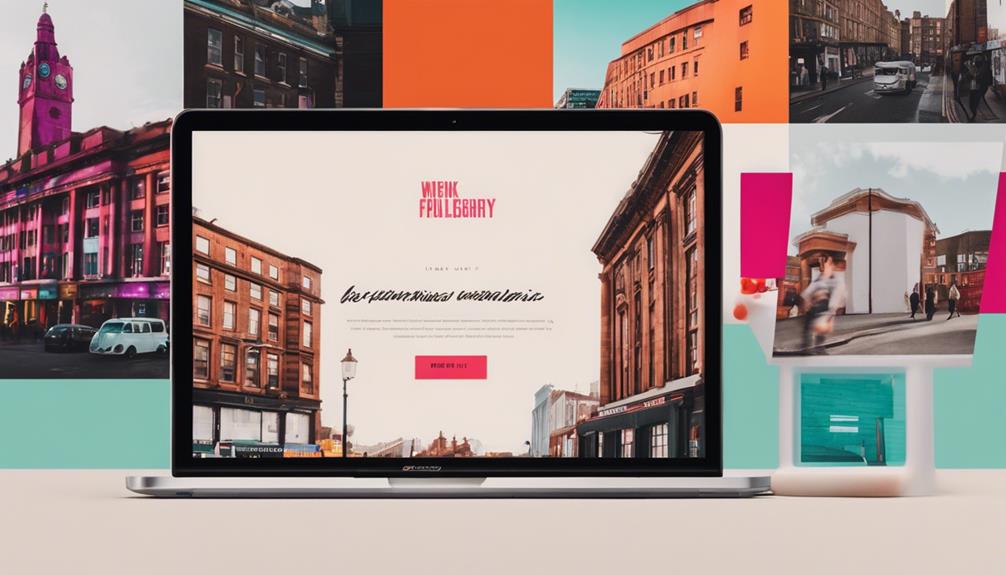In the fast-paced world of web design, the quest for creative inspiration is a continuous journey that requires a keen eye for detail and a deep understanding of design principles.
From the latest trends to the subtle nuances of color psychology, unlocking the door to innovative web design involves a multi-faceted approach.
By delving into the realms of mood boards, minimalism, and user experience, designers can create visually captivating and user-friendly websites.
However, the key to truly groundbreaking design often lies in seeking inspiration beyond the digital realm, where unconventional sources can spark fresh ideas and unique perspectives.
Understanding Design Trends

In the rapidly evolving field of web design, understanding current design trends is paramount for creating visually appealing and user-friendly websites. Keeping up with web design trends allows designers to stay ahead of the curve, ensuring that websites remain relevant and engaging for users. Drawing inspiration from popular design trends can help creative web design agencies produce innovative and cutting-edge websites that captivate audiences.
Web design trends encompass various aspects, including layout styles, typography choices, color schemes, and interactive features. By studying and implementing these trends, designers can enhance the user experience and create memorable online platforms. Additionally, staying informed about emerging design trends can differentiate a creative web design agency in a competitive market, showcasing their ability to deliver modern and visually striking websites.
Incorporating the latest web design trends not only demonstrates a designer's proficiency but also reflects a commitment to delivering high-quality and innovative solutions for clients. By embracing inspiration from current design trends, creative web design agencies can elevate their work and set new standards for web design excellence.
Exploring Color Psychology
Understanding the significance of color psychology in web design enhances the ability of designers to create visually impactful and emotionally engaging online experiences for users. Color psychology plays a crucial role in evoking specific emotions, setting the tone, and influencing user behavior on websites. Different colors have distinct psychological effects on individuals. For example, warm colors like red and orange tend to create a sense of urgency or excitement, while cool colors like blue and green evoke feelings of calmness and trust. By strategically applying color psychology principles, designers can steer users towards desired actions, such as making a purchase or subscribing to a service.
Incorporating color psychology into web design not only enhances the aesthetic appeal of a website but also contributes to its functionality. Colors can help in establishing brand identity, improving readability, and guiding users' navigation through the site. By understanding how colors influence emotions and perceptions, designers can create compelling visual experiences that resonate with the target audience, ultimately leading to a more engaging and effective website design.
Leveraging Mood Boards

Exploring the visual essence of web design often begins with leveraging mood boards to inspire and guide the creative direction of a project. Mood boards are powerful tools that help designers compile a collection of images, colors, textures, and typography that capture the desired look and feel of a website. By curating elements that resonate with the brand identity and target audience, mood boards serve as a visual representation of the web design ideas and inspiration behind a project.
When creating a mood board for creative web design, it is essential to gather diverse sources of inspiration, from nature and architecture to art and fashion. By exploring a wide range of visuals, designers can spark new ideas and approaches that elevate the overall design concept. Additionally, mood boards facilitate communication and collaboration among team members, ensuring a cohesive vision throughout the web design process.
In essence, leveraging mood boards in web design is a strategic way to kickstart creativity, refine concepts, and ultimately bring a unique and visually compelling website to life.
Embracing Minimalism
Embracing minimalism in web design enhances user experience by prioritizing essential elements and simplifying visual clutter. Minimalism is a key principle of modern web design, focusing on clean layouts, ample white space, and a simplified color palette. By adhering to minimalist principles, websites can achieve a sleek and sophisticated look that is visually appealing and easy to navigate.
Incorporating minimalism into web design not only improves aesthetics but also enhances functionality. Minimalist websites load faster, provide a seamless user experience across different devices, and allow for easier navigation. This design approach ensures that users can quickly find the information they need without being overwhelmed by unnecessary elements.
Furthermore, minimalism can help highlight key content and calls to action, leading to higher conversion rates. By stripping away distractions and focusing on what truly matters, minimalist web design can effectively communicate a brand's message and encourage user engagement. Embracing minimalism is a powerful strategy for creating websites that are both visually striking and user-friendly.
Incorporating User Experience Principles

To optimize user engagement and satisfaction, web designers must strategically incorporate user experience principles into their design strategies. User experience (UX) and user interface (UI) web design are crucial components that directly impact how visitors interact with a website. UX web design focuses on enhancing the overall experience users have while navigating a site, aiming to make it seamless, intuitive, and enjoyable. On the other hand, UI web design concentrates on the visual elements users interact with, such as buttons, menus, and forms, ensuring they are aesthetically pleasing and user-friendly.
Incorporating user experience principles involves understanding the target audience, designing with usability in mind, and continuously testing and refining the website based on user feedback. By prioritizing user experience, designers can create websites that not only look visually appealing but also function effectively and provide a positive experience for visitors. Implementing UX and UI web design principles results in improved user satisfaction, increased engagement, and higher conversion rates, ultimately leading to the success of a website.
Seeking Inspiration Outside the Web
Drawing from diverse sources beyond the digital realm can invigorate web designers' creativity and bring fresh perspectives to their design approach. For web design creatives looking to break out of the digital bubble, seeking inspiration outside the web can be a game-changer. Exploring art galleries, attending design conferences, or even taking up a new hobby can fuel creativity and provide unique insights that can be translated into innovative web designs.
Web design agencies can encourage their teams to step away from their screens and immerse themselves in different environments to spark fresh ideas. By learning web design principles from unconventional sources such as architecture, nature, or fashion, designers can broaden their skill set and enhance their problem-solving capabilities.
For individuals learning web design, looking beyond the traditional online resources can offer a well-rounded education. By studying diverse disciplines and observing the world around them, aspiring designers can cultivate a more holistic approach to web design that sets them apart in a competitive industry.
Frequently Asked Questions
How Can I Overcome Creative Blocks and Boost My Inspiration When Designing for the Web?
To overcome creative blocks and boost inspiration in web design, explore diverse design styles, seek feedback from peers, engage in brainstorming sessions, take breaks to refresh your mind, study other websites for inspiration, and stay updated on industry trends.
What Are Some Unconventional Sources of Inspiration That Web Designers Can Look to for Fresh Ideas?
Web designers seeking fresh ideas can explore diverse sources of inspiration like nature, architecture, art, fashion, and travel. Drawing from unconventional realms can spark unique creativity and offer innovative perspectives for web design projects.
How Can I Effectively Translate Abstract Concepts and Emotions Into Visually Appealing Web Design Elements?
Effectively translating abstract concepts and emotions into visually appealing web design elements involves understanding the core message, identifying key visual cues, and using color, typography, and imagery strategically to convey the desired emotions and concepts accurately.
Are There Any Specific Techniques or Exercises That Can Help Me Tap Into My Creativity and Think Outside the Box When Designing for the Web?
Exploring various design styles, experimenting with color palettes, sketching initial concepts, and seeking inspiration from nature or art can help foster creativity. Engaging in brainstorming sessions, collaborating with others, and taking breaks can also stimulate innovative thinking.
How Important Is It for Web Designers to Stay Updated on the Latest Technology and Design Tools, and How Can They Incorporate These Advancements Into Their Work?
Staying updated on technology and design tools is vital for web designers to remain competitive and deliver cutting-edge solutions. Incorporating advancements enhances efficiency, user experience, and innovation, ultimately positioning professionals as industry leaders and meeting evolving client demands.










